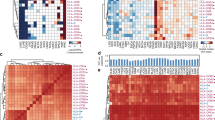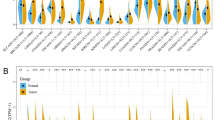Abstract
Immune checkpoint molecules are highly relevant as potential prognostic markers and therapeutic targets in malignant diseases. HVEM belongs to the TNF receptor family and provides stimulatory as well as inhibitory signals depending on the ligand. Abnormal HVEM expression has been described in various malignancies, but the role in AML is unknown. Here we report extensive data on HVEM surface protein expression analyzed by flow cytometry on bone marrow leukemic cells of 169 AML patients at diagnosis. An independent cohort of 512 AML patients was analyzed for HVEM mRNA expression in bone marrow samples by Affymetrix microarrays. Consistently for both cohorts and methods, we show that HVEM was differentially expressed and that expression levels were associated with defined genetic markers. HVEM expression was lower in cases with FLT3-ITD (p = 0.001, p < 0.001), with mutations in NPM1 (p = 0.001, p < 0.001) or with the combination of NPM1 mutation and FLT3 wild type (p = 0.049, p = 0.050), while a biallelic mutation in CEBPA correlated positively with higher HVEM expression (p = 0.015, p < 0.001). In a differential gene expression analysis, we found 13 genes including HOXA9, MEIS1 and MN1 that were closely associated with HVEM expression. Besides, four gene sets closely linked to immunity were enriched in HVEM high samples. Finally, high expression of HVEM was associated with a trend toward longer relapse-free survival. The results of this study provide new information on the potential significance of HVEM in AML.




Similar content being viewed by others
Abbreviations
- AML:
-
Acute myeloid leukemia
- AML-CG:
-
AML Cooperative Group
- BM:
-
Bone marrow
- CEBPA:
-
CCAAT/enhancer-binding protein alpha
- CR:
-
Complete remission
- ELN:
-
European LeukemiaNet
- FLT3:
-
Fms-like tyrosine kinase 3
- GSEA:
-
Gene set enrichment analysis
- HVEM:
-
Herpesvirus entry mediator
- Limma:
-
Linear Models for Microarray Data
- MFI:
-
Mean fluorescence intensity
- MRC:
-
Medical Research Council
- NPM1:
-
Nucleophosmin
- OS:
-
Overall survival
- RFS:
-
Relapse-free survival
- sAML:
-
Secondary AML
- SCT:
-
Stem cell transplantation
- SFI:
-
Specific fluorescence intensity
- TNFR:
-
Tumor necrosis factor receptor
References
Pasero C, Speiser DE, Derré L, Olive D (2012) The HVEM network: new directions in targeting novel costimulatory/co-inhibitory molecules for cancer therapy. Curr Opin Pharmacol 12:478–485
Morel Y, Truneh A, Sweet RW, Olive D, Costello RT (2001) The TNF superfamily members LIGHT and CD154 (CD40 ligand) costimulate induction of dendritic cell maturation and elicit specific CTL activity. J Immunol 167:2479–2486
Duhen T, Pasero C, Mallet F, Barbarat B, Olive D, Costello RT (2004) LIGHT costimulates CD40 triggering and induces immunoglobulin secretion; a novel key partner in T cell-dependent B cell terminal differentiation. Eur J Immunol 34:3534–3541
Murphy TL, Murphy KM (2010) Slow down and survive: enigmatic immunoregulation by BTLA and HVEM. Annu Rev Immunol 28:389–411
Wang Y, Subudhi SK, Anders RA, Lo J, Sun Y, Blink S, Wang Y, Wang J, Liu X, Mink K, Degrandi D, Pfeffer K, Fu YX (2005) The role of herpesvirus entry mediator as a negative regulator of T cell-mediated responses. J Clin Invest 115:711–717
del Rio ML, Lucas CL, Buhler L, Rayat G, Rodriguez-Barbosa JI (2010) HVEM/LIGHT/BTLA/CD160 cosignaling pathways as targets for immune regulation. J Leukoc Biol 87:223–235
Costello RT, Mallet F, Barbarat B, De Colella JMS, Sainty D, Sweet RW, Truneh A, Olive D (2003) Stimulation of non-Hodgkin’s lymphoma via HVEM: an alternate and safe way to increase Fas-induced apoptosis and improve tumor immunogenicity. Leukemia 17:2500–2507
Derré L, Rivals JP, Jandus C, Pastor S, Rimoldi D, Romero P, Michielin O, Olive D, Speiser DE (2010) BTLA mediates inhibition of human tumor-specific CD8+ T cells that can be partially reversed by vaccination. J Clin Invest 120:157–167
Migita K, Sho M, Shimada K, Yasuda S, Yamato I, Takayama T, Matsumoto S, Wakatsuki K, Hotta K, Tanaka T, Ito M, Konishi N, Nakajima Y (2014) Significant involvement of herpesvirus entry mediator in human esophageal squamous cell carcinoma. Cancer 120:808–817
Hokuto D, Sho M, Yamato I, Yasuda S, Obara S, Nomi T, Nakajima Y (2015) Clinical impact of herpesvirus entry mediator expression in human hepatocellular carcinoma. Eur J Cancer 51:157–165
Inoue T, Sho M, Yasuda S, Nishiwada S, Nakamura S, Ueda T, Nishigori N, Kawasaki K, Obara S, Nakamoto T, Koyama F, Fujii H, Nakajima Y (2015) HVEM expression contributes to tumor progression and prognosis in human colorectal cancer. Anticancer Res 35:1361–1367
Pasero C, Barbarat B, Just-Landi S, Bernard A, Aurran-Schleinitz T, Rey J, Eldering E, Truneh A, Costello RT, Olive D (2009) A role for HVEM, but not lymphotoxin-beta receptor, in LIGHT-induced tumor cell death and chemokine production. Eur J Immunol 39:2502–2514
Hobo W, Norde WJ, Schaap N, Fredrix H, Maas F, Schellens K, Falkenburg JH, Korman AJ, Olive D, van der Voort R, Dolstra H (2012) B and T lymphocyte attenuator mediates inhibition of tumor-reactive CD8+ T cells in patients after allogeneic stem cell transplantation. J Immunol 189:39–49
Grimwade D, Hills RK, Moorman AV, Walker H, Chatters S, Goldstone AH, Wheatley K, Harrison CJ, Burnett AK, National Cancer Research Institute Adult Leukaemia Working Group (2010) Refinement of cytogenetic classification in acute myeloid leukemia: determination of prognostic significance of rare recurring chromosomal abnormalities among 5876 younger adult patients treated in the United Kingdom Medical Research Council trials. Blood 116:354–365
Li Z, Herold T, He C, Valk PJ, Chen P, Jurinovic V, Mansmann U, Radmacher MD, Maharry KS, Sun M, Yang X, Huang H, Jiang X, Sauerland MC, Büchner T, Hiddemann W, Elkahloun A, Neilly MB, Zhang Y, Larson RA et al (2013) Identification of a 24-gene prognostic signature that improves the European LeukemiaNet risk classification of acute myeloid leukemia: an international collaborative study. J Clin Oncol 31:1172–1181
Ritchie ME, Phipson B, Wu D, Hu Y, Law CW, Shi W, Smyth GK (2015) limma powers differential expression analyses for RNA-sequencing and microarray studies. Nucleic Acids Res 43:e47
Subramanian A, Tamayo P, Mootha VK, Mukherjee S, Ebert BL, Gillette MA, Paulovich A, Pomeroy SL, Golub TR, Lander ES, Mesirov JP (2005) Gene set enrichment analysis: a knowledge-based approach for interpreting genome-wide expression profiles. Proc Natl Acad Sci USA 102:15545–15550
Lawrence HJ, Rozenfeld S, Cruz C, Matsukuma K, Kwong A, Kömüves L, Buchberg AM, Largman C (1999) Frequent co-expression of the HOXA9 and MEIS1 homeobox genes in human myeloid leukemias. Leukemia 13:1993–1999
Zhao P, Tan L, Ruan J, Wei XP, Zheng Y, Zheng LX, Jiang WQ, Fang WJ (2015) Aberrant expression of HOXA5 and HOXA9 in AML. Asian Pac J Cancer Prev 16:3941–3944
Li Z, Zhang Z, Li Y, Arnovitz S, Chen P, Huang H, Jiang X, Hong GM, Kunjamma RB, Ren H, He C, Wang CZ, Elkahloun AG, Valk PJ, Döhner K, Neilly MB, Bullinger L, Delwel R, Löwenberg B, Liu PP et al (2013) PBX3 is an important cofactor of HOXA9 in leukemogenesis. Blood 121:1422–1431
Metzeler KH, Dufour A, Benthaus T, Hummel M, Sauerland MC, Heinecke A, Berdel WE, Büchner T, Wörmann B, Mansmann U, Braess J, Spiekermann K, Hiddemann W, Buske C, Bohlander SK (2009) ERG expression is an independent prognostic factor and allows refined risk stratification in cytogenetically normal acute myeloid leukemia: a comprehensive analysis of ERG, MN1, and BAALC transcript levels using oligonucleotide microarrays. J Clin Oncol 27:5031–5038
Döhner H, Estey EH, Amadori S, Appelbaum FR, Büchner T, Burnett AK, Dombret H, Fenaux P, Grimwade D, Larson RA, Lo-Coco F, Naoe T, Niederwieser D, Ossenkoppele GJ, Sanz MA, Sierra J, Tallman MS, Löwenberg B, Bloomfield CD, LeukemiaNet European (2010) Diagnosis and management of acute myeloid leukemia in adults: recommendations from an international expert panel, on behalf of the European LeukemiaNet. Blood 115:453–474
Pasero C, Olive D (2013) Interfering with coinhibitory molecules: BTLA/HVEM as new targets to enhance anti-tumor immunity. Immunol Lett 151:71–75
Lichtenegger FS, Schnorfeil FM, Hiddemann W, Subklewe M (2013) Current strategies in immunotherapy for acute myeloid leukemia. Immunotherapy 5:63–78
Lichtenegger FS, Krupka C, Köhnke T, Subklewe M (2015) Immunotherapy for acute myeloid leukemia. Semin Hematol 52:207–214
Zhong RK, Loken M, Lane TA, Ball ED (2006) CTLA-4 blockade by a human MAb enhances the capacity of AML-derived DC to induce T-cell responses against AML cells in an autologous culture system. Cytotherapy 8:3–12
Bashey A, Medina B, Corringham S, Pasek M, Carrier E, Vrooman L, Lowy I, Solomon SR, Morris LE, Holland HK, Mason JR, Alyea EP, Soiffer RJ, Ball ED (2009) CTLA4 blockade with ipilimumab to treat relapse of malignancy after allogeneic hematopoietic cell transplantation. Blood 113:1581–1588
Berger R, Rotem-Yehudar R, Slama G, Landes S, Kneller A, Leiba M, Koren-Michowitz M, Shimoni A, Nagler A (2008) Phase I safety and pharmacokinetic study of CT-011, a humanized antibody interacting with PD-1, in patients with advanced hematologic malignancies. Clin Cancer Res 14:3044–3051
Zhou Q, Munger ME, Highfill SL, Tolar J, Weigel BJ, Riddle M, Sharpe AH, Vallera DA, Azuma M, Levine BL, June CH, Murphy WJ, Munn DH, Blazar BR (2010) Program death-1 signaling and regulatory T cells collaborate to resist the function of adoptively transferred cytotoxic T lymphocytes in advanced acute myeloid leukemia. Blood 116:2484–2493
Zhou Q, Munger ME, Veenstra RG, Weigel BJ, Hirashima M, Munn DH, Murphy WJ, Azuma M, Anderson AC, Kuchroo VK, Blazar BR (2011) Coexpression of Tim-3 and PD-1 identifies a CD8+ T-cell exhaustion phenotype in mice with disseminated acute myelogenous leukemia. Blood 117:4501–4510
Spranger S, Spaapen RM, Zha Y, Williams J, Meng Y, Ha TT, Gajewski TF (2013) Up-regulation of PD-L1, IDO, and tregs in the melanoma tumor microenvironment is driven by CD8+ T cells. Sci Transl Med 5:200ra116
Acknowledgments
The authors would like to thank Maria Sauerland from the Institute for Biometrics and Clinical Research at the Westfälische Wilhelms-Universität Münster and all doctors of the participating centers for the recruitment of patients and help with acquisition of the clinical data; Elke Habben, Karin Hecht, Sabine Reinkunz and Ewelina Zientara for their excellent technical assistance; and the patients for providing the research samples used in this study. The work was supported by funds from BayImmuNet, the Bavarian Immunotherapy Network (http://www.bayimmunet.de), and by a Metiphys fellowship of the Medical Faculty of the Ludwig-Maximilian Universität München to Felix S. Lichtenegger.
Author contributions
Marion Subklewe was the principal investigator and takes primary responsibility for the paper. Thomas Büchner, Wolfgang E. Berdel, Bernhard J. Wörmann and Wolfgang Hiddemann were principle investigators of the AML-CG 99 trial and recruited the patients for this analysis. Karsten Spiekermann and Stephanie Schneider provided the morphological, cytogenetic and molecular characterization of the patients. Tobias Herold provided the mRNA expression data and their statistical analysis. Felix S. Lichtenegger, Isabell Kondla, Michael Krempasky and Anna L. Weber collected and analyzed the data. Felix S. Lichtenegger and Marion Subklewe coordinated the research and wrote the manuscript.
Author information
Authors and Affiliations
Corresponding author
Ethics declarations
Conflict of interest
The authors declare that they have no competing interest.
Electronic supplementary material
Below is the link to the electronic supplementary material.
Rights and permissions
About this article
Cite this article
Lichtenegger, F.S., Kondla, I., Krempasky, M. et al. RNA and protein expression of herpesvirus entry mediator (HVEM) is associated with molecular markers, immunity-related pathways and relapse-free survival of patients with AML. Cancer Immunol Immunother 64, 1505–1515 (2015). https://doi.org/10.1007/s00262-015-1755-8
Received:
Accepted:
Published:
Issue Date:
DOI: https://doi.org/10.1007/s00262-015-1755-8




